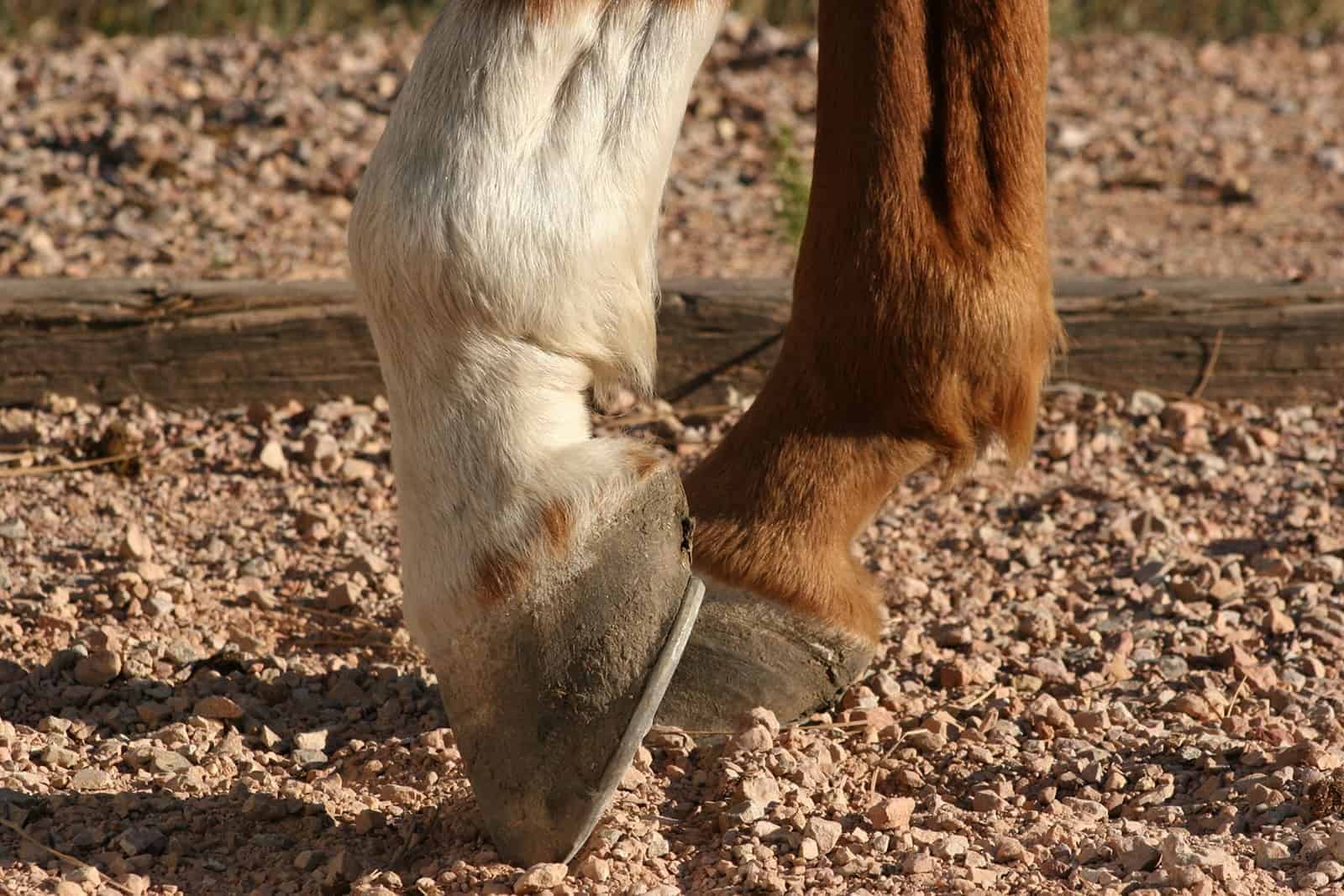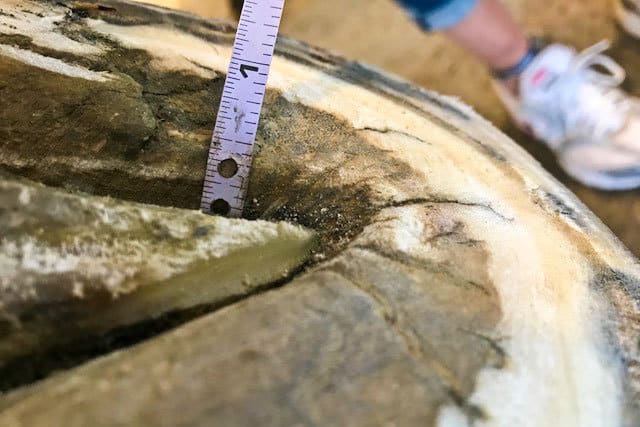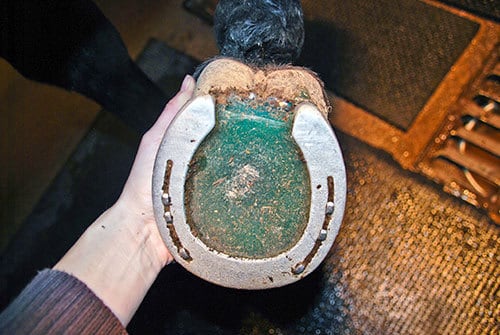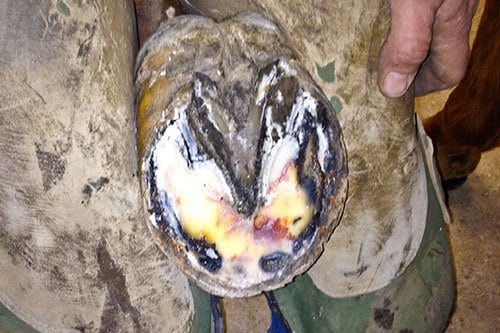A Window Into Your Horse’s Sole

If you’re lucky, your horse has been blessed with thick soles; if not, here’s how to manage his feet to help keep him sound.
A thick, strong sole on a horse’s foot lays the foundation for soundness. Too-thin soles can’t support the structures above them, potentially leading to hoof wall flares, distortions, and imbalances. These horses are also more likely to have poor hoof conformation and are more susceptible to bruising, tenderness, and even navicular issues and arthritis. And if they do develop a hoof condition, particularly one as serious as laminitis, they’re usually more challenging to rehabilitate.
In this article two veterinarians and a farrier will describe sole quality and management methods.
What Makes a Good Sole?
A healthy hoof has a strong, healthy sole. “A healthy sole grows a lot,” says Mike Pownall, DVM, of McKee-Pownall Equine Services, in Campbellville, Ontario, Canada. “It’s similar to healthy hair in humans; people who grow hair fast are usually pretty healthy. Good blood flow to a well-balanced foot, good nutrition, and adequate exercise lead to a healthy sole.”
More importantly, a healthy sole helps absorb shock and support and protect the foot’s sensitive inner structures, says Paul Goodness, chief of farrier services at Virginia Tech’s Marion duPont Scott Equine Medical Center, in Leesburg, Virginia.
A healthy sole is also thick, with large calloused areas, especially around the periphery. “Callouses are densely packed horny sole material,” says Goodness. “This facilitates weight-bearing, almost like a hoof wall. The horse can walk over rocks very nicely on calloused soles. They provide strong protective cover like a natural shoe.”
The sole should arch naturally from front to back and side to side, creating a nice concave surface. This provides flexibility to help dissipate concussion when the foot hits the ground. “During maximum weight-bearing the sole tends to flatten and redirect vertical load forces into lateral forces, which aids shock absorption,” Goodness says.

The conformation and shape of a horse’s coffin bone and the lateral cartilages—which slope upward and backward from the wings of the coffin bone and reach above the margin of the coronary band—dictate the conformation and shape of his sole.
One factor that affects sole health is environment—whether it’s wet or dry. In wet environments soles tend to get soft and wear thin more readily. “We often see sole problems with show horses because they spend so much time in the wash rack,” says Goodness.
Conversely, in dry areas horses’ soles tend to get rock hard and less apt to wear.
“Wet, soft soles are more easily injured, whereas a dry, hard sole is more durable,” says Pownall. “We had a very wet spring, and it continued into a wet summer. We typically get very dry in August, so this abrupt change can create problems. Feet have been wet and soft and very tender and become susceptible to bruising when the ground suddenly gets dry and hard.”
The horse’s job also plays a role in sole health. If he’s retired and turned out to pasture, his soles might not endure as much wear and tear as they would if he were used for endurance riding or traveling many miles a day on the range moving cattle. Use can help toughen a sole—just as a person going barefoot all summer gets tougher soles with time, the horse’s foot that’s tender at first becomes harder, more calloused, and not as easily injured.
“As a farrier and a veterinarian, I like to see a sole that has a little bit of give when you put some pressure on it (remember, the sole is a flexible, shock-absorbing structure) but this will depend on how dry and hard the foot is,” says Pownall. You might not get a good sense of how much sole is there or how thick it is if the foot is hard.
“We farriers probably have the most direct effect with our knives and rasps, in how we manipulate the sole and the balance we leave,” says Goodness. “This can have a profound effect on how thick the sole will be. An even balance generally equals an even sole. That’s the goal—a thick, even sole around the entire bottom of the foot.”
It Starts With the Genes
“Sole depth depends greatly on genetics,” says Julie Bullock, DVM, an equine practitioner and endurance competitor with an interest in podiatry who’s based in Lexington, Virginia. “My Mustang has strong feet with good soles, but I also own a Thoroughbred with thinner soles. Some horses can’t develop thicker soles no matter how hard you try; it’s like pushing a rock uphill. You just have to figure out how to deal with the foot that’s handed to you, and you also have to pick the right job for that horse.”
Genetics affect coffin bone shape, which, as we know, the sole mimics. Take, for instance, a draft horse’s coffin bone versus that of a typical Arabian. “Most Arabians have a concave sole,” says Goodness. “The draft horse sole is usually flat and broad in comparison to the cupped sole of the Arabian. The American Thoroughbred tends to have thinner, flatter soles than the average Morgan that has more upright hooves and naturally thick soles. I might wish my Warmblood or draft horse cross had a stronger sole, but it may not be possible—because of the shape of the coffin bone.”
Some breeds’ feet simply adapt to different environments better than other horses. “A Thoroughbred racehorse can be turned out in a soft environment in summer in the mid-Atlantic climate (very humid), and his sole will become thinner,” says Goodness. “By contrast, if you turn a Morgan out, he has a thicker sole to begin with, and it will only wear away a certain amount. Genetics is a big factor in how different horses deal with their environments.”

Determining Sole Depth
A good sole is about half an inch thick at the apex (point) of the frog, when you place a measuring instrument into the frog’s lateral grooves. Pownall says there’s usually a bit of a depression at the point of the frog, which helps you estimate the surrounding sole’s thickness.
Veterinarians can help farriers determine sole depth and thickness by taking hoof radiographs (X rays). “This technique has been a huge help because we see cases that are deceptive when you simply look at the foot,” says Pownall.
Of course, radiography equipment isn’t always on-hand when the farrier is trimming and shoeing. “They often have to use their best judgment and let the horse tell them how thick or thin the sole might be,” says Bullock. “The foot can lie, however. Looking at an X ray can increase the farrier’s comfort zone, to know how much can be safely taken off” when trimming.
When considering sole depth you must evaluate the entire hoof. “On a horse that hasn’t grown much sole, I look at foot conformation, balance, etc. and try to understand what is contributing to the lack of sole growth. Is it foot imbalance, lack of blood flow, or nutrition?” asks Pownall.
On the whole, you want the sole to be as thick as possible. “Rarely have I run into a situation where the sole is too thick, unless the horse has been wearing pads and the sole hasn’t had any wearing away,” says Goodness.
Managing Thin Soles
Whether due to genetics, nutrition, or conditions such as club feet, laminitis, and poor hoof balance, the horse with thin soles needs some help to prevent bruising and lameness.
Padding
Pownall says horses with thin soles need some kind of sole protection, particularly if walking on rock or gravel.
“Pads can help,” he says. “Often when I do pour-in packing to help protect the sole, this helps because it adds some support for the frog and heel area. I’ve seen horses grow more foot after we’ve used pour-in pads.”
To grow more sole, the horse’s frog also needs to be in contact with the ground and blood must be flowing through the foot. “A support pad extends the reach of the frog so it can have normal weight-bearing pressure, assist blood flow within the foot, and help accelerate the process of growing more sole,” says Pownall.

Bullock says when she recently took her horses on two very rocky endurance rides, she used full plastic pads on one horse and polyethylene pour-in pads on the other, thinner-soled horse. The pour-in consists of mesh placed over the sole over which the farrier distributes glue that sets into an instant, durable pad.
Pour-ins come in a variety of densities. For horses that are not comfortable with that kind of pressure on their soles, Bullock suggests sticking with a full pad.
Farriers can nail shoes directly over the pads if the horse tolerates it. With some horses, however, this makes the foot longer (due to the pad’s added height) and/or heavier, interfering with their movement and causing them to stumble.
If you don’t want the farrier to use nails on your thin-soled horse, Bullock recommends glue-on products. “Glue-on shoes often work great for thin soles; the horse may be more comfortable with this type of shoe rather than nailing on shoes and pads,” she says.
She says she’s also outfitted her sensitive horse with hoof boots.
Topicals
Some horses, no matter how well we manage them and their environments, simply cannot grow thicker soles. “Many have reached their genetic potential, and the sole is as thick as it can be,” says Goodness. “Something worth trying for these horses is topical paint-on products that tend to dry and toughen the sole so it won’t abrade away so easily.”
Years ago, before the advent of so many hoof products, farriers and horse owners just applied iodine to the sole to help dry and toughen it. “I still don’t find anything much better than 7% iodine,” says Goodness. “You can put some in a spray bottle and spray the bottom of the foot daily (taking care not to get any iodine on the hoof wall, which could dry the wall out, or above it, since it can burn the skin). This can help make the sole less tender.”

Trimming
The best way to nurture a thin sole is to avoid overtrimming it. “Farriers can get caught up in a vicious cycle when trimming the sole too thin,” says Goodness, referring to the process of using a hoof knife to neaten or remove excess sole. “If we trim it too much, usually unintentionally, the bony column may sink down in the hoof capsule, creating a too-long hoof, which necessitates more trimming to keep toes short enough so as not to create undue stress on the leg.”
He says he prefers to trim soles with just a wire brush, rather than a knife or rasp, and let them self-adjust.
“We need to allow the sole to build up on its own; we can’t attempt to trim a cup into a flat sole. It needs to do that naturally,” he adds.
Your farrier should evaluate the sole each time he or she works on your horse. Hoof testers can help reveal whether the sole is pliable or tender and sensitive, as well as how much force it takes for the horse to feel that pressure, which will dictate trimming or shoeing plans, says Bullock.
Shoeing
Shoes, often in conjunction with a pad or support material, can help protect the sole and prevent excessive wear. “I’ve worked with horses that had paper-thin soles and the only way for them to be comfortable was protection with a shoe,” Goodness says.
“There are some tricks and aids that might increase sole growth and depth, and even concavity in some horses,” says Bullock. “Some flat-footed horses that I’ve shod with impression material (e.g., pour-ins) ended up with tremendous concavity. You can influence growth and shape of the sole and help it become healthier.”
Take-Home Message
Balanced nutrition, regular exercise, protection such as pads, and attention to environment can help your horse grow a healthier sole. Be proactive and learn about your horse’s feet. Get a good veterinarian-farrier team involved, and understand that some horses just have stronger soles than others.
“We can’t change the genetics,” says Bullock. “We may be able to make some modifications long-term, but we mainly have to do the best (we can) with what we have.”
Written by:
Heather Smith Thomas
Related Articles
Stay on top of the most recent Horse Health news with















